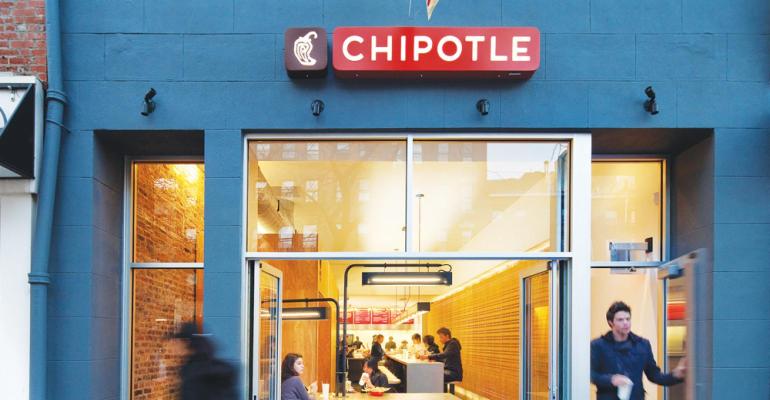Chipotle reported first quarter results after market close Wednesday and the company once again bucked the industry’s declining traffic trends, turning in a plus-5% increase in transactions. Credit Chicken Al Pastor, barbacoa, and improved throughput to meet demand for both.
The company also generated 7% comp sales growth, while system sales grew 15% to reach $2.7 billion. CEO Brian Niccol said in-store sales were up by nearly 20% as throughput reached its highest level in four years. That throughput improvement has stemmed from the company’s Project Square One, first put into place during the summer of 2022 to prioritize a focus on operational fundamentals for a workforce that largely dissipated during the pandemic. The company improved its throughput by nearly two entrees during its peak 15-minute timeframe versus last year, with sequential improvements each month. Niccol said its operations initiative focuses on four areas, including expediting the bagging and payment process and ensuring the manager supplies both lines with food to avoid interruption.
“We’re in the early innings of consistently executing the four pillars, but when we do, it creates a flywheel effect in our restaurants,” Niccol said. “Restaurants run more smoothly as our teams are properly trained and deployed, which allows them to keep up with demand without stress. This leads to more stability.”
In addition to focusing on operations, Chipotle also tweaked its barbacoa promotion, renaming it braised beef barbacoa, which drove incremental transactions and spend.
“We leveraged our consumer insights that told us many of our guests did not know that barbacoa was braised beef, so we renamed it braised beef barbacoa,” Niccol said. “It was Chipotle’s best kept secret and is now growing in popularity.”
Chipotle’s Chicken Al Pastor, which was brought back to the menu in March, has also boosted incremental transactions so far.
Meanwhile, digital sales hovered at 37% of sales, while rewards membership reached about 40 million. Niccol said the company is striving to drive even higher engagement in the program and, during the quarter, the company began identifying less frequent consumers to try to keep them in the mix.
“That’s proving to be pretty powerful. We’ll take that learning and figure out how to apply it on a much bigger scale so that then you can feel it across the digital business,” Niccol said. “I think the team is doing a nice job of commercializing the data in an effective way that feels like more personalization, more relevance. When we keep the engagement up, we see the higher spend and more frequency.”
In-store, the company is exploring technology that can help with forecasting, labor deployment, labor recruitment and prep automation. In January, Chipotle rolled out a system to give employees real-time visibility, so that they are more aware of their operational cadence.
“There’s still so much upside in what our teams can do and perform. You’re going to hear us talking about throughput for a long time,” he said, adding that speed begets speed. “When you see the lines moving faster, you’re more willing to get in line.”
This is why the in-store channel was the fastest-growing channel during the quarter, Hartung added. Perhaps surprisingly, the improvement in throughput has led to a shift to in-store from some order-ahead business.
"When the lines are moving well, people like to come in and select their meal along the frontline," Hartung said.
Traffic coming from everywhere
Notably, Chipotle’s traffic gains came despite a challenging January in which weather impacted results across the industry, including at Chipotle. Niccol said the company recovered quickly and now its traffic gains are coming from across all income demographics and dayparts.
“It’s broad-based. From the low-income consumer to the middle income to the higher income consumer, we’re just seeing gains with all income cohorts,” Niccol said. “When we ask why, we hear back from every group it’s a great value proposition.”
California
CFO Jack Hartung said Chipotle took a 6% to 7% menu price increase in California to cover the minimum wage increase that went into effect April 1 in the state. This will add nearly a full point to total company pricing beginning in Q2, he added.
“California restaurant cash flow is below the company average, so this increase will allow us to maintain cash flow,” he said. “However, it will have a negative impact to overall restaurant-level margins by about 20 basis points.”
The company expects labor costs to remain in the mid-24% range in Q2, though wage inflation is expected to increase by about 6% because of California’s new wage rates. According to Technomic Ignite data, Chipotle finished 2023 with about 450 locations California, out of about 3,370 total.
By the numbers
In addition to sales and transaction increases, Chipotle’s restaurant-level margins reached 27.5% in Q1, an increase of 190 basis points year-over-year.
Forty-seven new restaurants were opened during the quarter, 43 of which were Chipotlane models.
The company is on track to open 285 to 315 new restaurants this year, mostly in North America.
Niccol said this first quarter momentum has so far continued into Q2 and, accordingly, the company is raising its comp guidance to be in the mid-to-high-single digit range for the full year.
Contact Alicia Kelso at [email protected]





